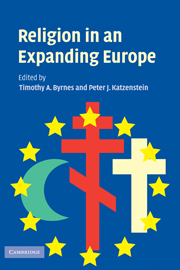Book contents
- Frontmatter
- Contents
- List of contributors
- Preface
- 1 Multiple modernities as limits to secular Europeanization?
- Part I European settings
- Part II Catholicism
- Part III Orthodoxy
- 6 The way we were – and should be again? European Orthodox Churches and the “idyllic past”
- 7 The politics of ambivalence: Europeanization and the Serbian Orthodox Church
- Part IV Islam
- Part V Conclusion
- References
- Index
6 - The way we were – and should be again? European Orthodox Churches and the “idyllic past”
Published online by Cambridge University Press: 22 September 2009
- Frontmatter
- Contents
- List of contributors
- Preface
- 1 Multiple modernities as limits to secular Europeanization?
- Part I European settings
- Part II Catholicism
- Part III Orthodoxy
- 6 The way we were – and should be again? European Orthodox Churches and the “idyllic past”
- 7 The politics of ambivalence: Europeanization and the Serbian Orthodox Church
- Part IV Islam
- Part V Conclusion
- References
- Index
Summary
Mainline Churches are, by nature, conservative. This is not so much because they are loath to change a successful formula, as because they are loath to change any formula, come what may. It is the essence of the great monotheistic religions (Christianity, Islam, Judaism) to experience difficulty in distinguishing between those formulae developed thousands of years ago which have lost whatever utility (if any) they may have had and such moral truths as are truly universal and everlasting. While most, if not all, religions embrace a range of opinion, from conservative to liberal (if not from ultra-conservative to left-liberal), the Orthodox Church is distinguished from other large religious organizations by the greater dominance of conservatives in its power structure and by the largely conservative orientation of even its “liberals.” Orthodoxy, thus, is a religion which – to quote Shakespeare – “looks on tempests and is never shaken” – not even when it should be. Whatever changes may impact the world, the Orthodox Church refuses, for the most part, to accommodate itself to change, standing fixed in time, its bishops' gaze riveted on an “idyllic past” which serves as their beacon. For Orthodoxy, time stands still. Why is this? It would be nice to offer a simple, one-line answer.
- Type
- Chapter
- Information
- Religion in an Expanding Europe , pp. 148 - 175Publisher: Cambridge University PressPrint publication year: 2006
- 21
- Cited by

